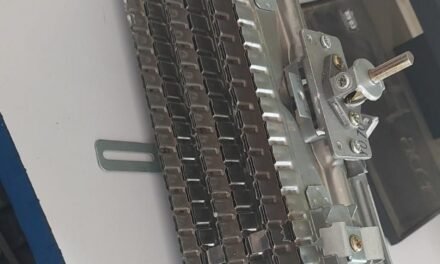28 September 2025
I had a discussion with Dixit Sir. In that discussion, it was decided that after spinach, we will grow Aster plants in the hydroponic system. For this, I need to find out which type of hydroponic system is suitable for Aster plants. Also, documentation has to be prepared on Aster plants, and after that, the next discussion will be held .
The link below refers to the Aster document :
Aster
- Botanical Name: Callistephus chinensis
- Common Name: Aster
- Family: Asteraceae
- Type: Annual ornamental flowering plant
- Origin: Native to China, widely cultivated globally for cut flowers and garden decoration.
Aster is popular for its vibrant, daisy-like flowers that come in a variety of colors such as purple, pink, red, white, and blue. It is highly valued in floriculture due to its long-lasting blooms and aesthetic appeal.
2. Plant Characteristics :
- Height: Typically 30–90 cm depending on variety and cultivation conditions.
- Leaves: Simple, lance-shaped, arranged alternately on the stem.
- Flowers: Composite flowers with central disc florets and surrounding ray florets.
- Blooming Period: Generally blooms in late summer to autumn (8–12 weeks after planting).
- Life Cycle: Short-lived annual, completing its life cycle in one growing season.
3. Uses:
- Cut Flower Production: Stems are long and sturdy, suitable for bouquets and floral arrangements.
- Ornamental Gardening : Ideal for beds, borders, and containers
- Research Crop: Due to its predictable growth, it is used in floriculture experiments and hydroponic research.
Aster in Hydroponics
- Aster (Callistephus chinensis) is a popular cut-flower crop.
- It grows well in soilless culture, but requires careful nutrient and EC management.
- Hydroponics helps get uniform flower size, better stem length, and controlled flowering.
1. Best Hydroponic Systems for Aster:
- NFT (Nutrient Film Technique): Good for leafy crops, but not ideal for long-term flowering plants like Aster (roots need more stability).
- DWC (Deep Water Culture): Roots may become too waterlogged → fungal risk.
- Drip Irrigation / Dutch Bucket (recommended):Provides stable root support (using cocopeat, perlite, or rockwool). Controlled nutrient supply.Best suited for flowering crops like Aster, Gerbera, Chrysanthemum.
Aster in DWC Hydroponics
Possible
- In DWC, roots stay directly in the nutrient solution → allows fast nutrient uptake.
- Aster can grow if proper aeration is provided.
Challenge:
- Risk of Root Rot – Flowering crops like Aster have a long growth cycle, and since roots remain continuously in water in DWC, the chance of fungal infections (Pythium, Fusarium) is high.
- Plant Support – Aster needs strong stems and support; in DWC, only net pots with Hydroton/coco chips provide support. For large flowering plants, this may be somewhat unstable.
- Nutrient Fluctuation – For long-term crops, maintaining a stable solution is difficult; EC and pH need frequent monitoring.
Precautions if using DWC
- Strong Aeration: 1–2 air stones in tank
- Water Temperature: 20–24 °C (warm water increases disease risk)
- Use Net Pots with Media: Hydroton + cocopeat/perlite mix for stem support.
- Disinfect System Regularly: Use H₂O₂ or other sterilizers for the root zone.
- Change Solution: Every 7–10 days.
Growing media for Aster Hydroponic
| Media | Ratio / Mix | Features | Notes |
|---|---|---|---|
| Cocopeat + Perlite | 70:30 | Water retention + aeration balance | Most common and easy to manage |
| Cocopeat + Vermiculite + Perlite | 50:25:25 | Better moisture + oxygen balance | Suitable for seedling to flowering stage |
| Perlite + Vermiculite | 1:1 | Very light & good drainage | Use if system continuously nutrient flow (like NFT or drip) |
| Rockwool | Pure or with perlite | Sterile, pH neutral | Best for nursery but costly |
| LECA (Clay balls) | 100% or with cocopeat (50:50) | Reusable, high aeration | Best for DWC or Dutch bucket system |
Aster – Hydroponic Environmental Requirements :
| Parameter | Ideal Range | Notes |
| pH | 5.8 – 6.2 | Keep stable; check regularly; outside this range nutrient uptake decreases |
| EC (Electrical Conductivity) | 2.0 – 2.5 mS/cm | Too high → leaf burn; too low → poor flowering |
| Young seedlings | 1.8–2.0 mS/cm | |
| flowering plants | 2.3–2.5 mS/cm. | |
| Water Temperature | 20 – 24°C | Cooler water improves root oxygenation; warmer water → disease risk |
| Air Temperature | 18 – 24°C | Aster prefers mild, cool conditions; avoid frost |
| Humidity | 50 – 70% | Too high → fungal infection (Pythium, Fusarium) risk |
| Light | 12–14 hours/day | 200–300 µmol/m²/s (LED or sunlight); sufficient light promotes flowering |
| Other Notes | – | Long photoperiod helps uniform flowering; heat stress >26°C may reduce stem strength and flower quality |
EC (Electrical Conductivity) – 2.0–2.5 mS/cm
1. What EC Means:
- EC measures the total concentration of dissolved salts/nutrients in your hydroponic solution.
- Higher EC = more nutrients; Lower EC = fewer nutrients.
- Units: mS/cm (milliSiemens per centimeter).
- Ideal Range for Aster:
- 2.0 – 2.5 mS/cm is ideal for hydroponic Aster.
- Ensures the plant gets enough nutrients for healthy stem growth, leaf development, and flowering.
3. Effects of Too High EC (>2.5 mS/cm):
- Leaf Burn / Tip Burn: Excess salts cause osmotic stress; water moves out of leaf cells → burning at leaf tips.
- Stunted Growth: Roots may be damaged; nutrient uptake becomes inefficient.
- Reduced Flower Quality: Flower size and stem length may decrease.
4. Effects of Too Low EC (<2.0 mS/cm):
- Nutrient Deficiency: Plant doesn’t get enough macro- and micronutrients (N, P, K, Ca, Mg, Fe).
- Poor Flowering: Stems may be weak, fewer blooms, delayed flowering.
- Leaf Yellowing or Poor Leaf Development: Leaves may turn pale due to nitrogen or iron deficiency .
5. Managing EC in Hydroponics:
- Monitor Daily: Use a reliable EC meter.
- Adjust Nutrients Gradually: Add concentrated nutrient solution to raise EC or dilute with water to lower EC.
- Account for Crop Stage: Young seedlings may need slightly lower EC (1.8–2.0 mS/cm), while flowering plants can handle 2.3–2.5 mS/cm.
- Temperature Factor: Warm water increases nutrient uptake; adjust EC accordingly to avoid over-fertilization.
Aeration in DWC
- In a DWC (Deep Water Culture) system, the plant roots stay directly in the water (nutrient solution).
- If there is no oxygen in the water → the roots will “suffocate” and root rot will occur.
- Therefore, it is essential to maintain dissolved oxygen (DO) in the water.
What is an Air Stone?
- A small porous stone or mesh-like device commonly used in aquariums.
- It is connected to an air pump.
- Air comes from the pump → tiny bubbles come out of the stone.
- These bubbles dissolve oxygen into the nutrient water.
Standard Nutrient Requirement for Aster :
| Nutrient | Recommended Concentration (ppm) | Target ppm | Role in Aster |
| Nitrogen (N) | 150 – 180 ppm | 165 ppm | Vegetative growth, stem length |
| Phosphorus (P) | 40 – 50 ppm | 45 ppm | Root growth, bud initiation |
| Potassium (K) | 180 – 220 ppm | 200 pm | Strong stems, flower color & size |
| Calcium (Ca) | 140 – 160 ppm | 150 ppm | Cell wall strength, disease resistance |
| Magnesium (Mg) | 40 – 60 ppm | 50 ppm | Chlorophyll, prevents interveinal yellowing |
| Sulfur (S) | 50 – 70 ppm | 60 ppm | Protein synthesis, flower quality |
| Iron (Fe) | 2.0 – 3.0 ppm | 2.5 ppm | Prevents chlorosis |
| Manganese (Mn) | 0.5 – 1.0 ppm | 0.7 ppm | Enzyme activity |
| Zinc (Zn) | 0.05 – 0.1 ppm | 0.1 ppm | Hormone regulation, leaf expansion |
| Copper (Cu) | 0.05 ppm | 0.005 ppm | Enzyme activation |
| Boron (B) | 0.3 – 0.5 ppm | 0.4 ppm | Flower & seed development |
| Molybdenum (Mo) | 0.05 ppm | 0.05 ppm | Nitrogen metabolism |
Nutrient Requirement
- Vegetative stage: Higher nitrogen for leaf and stem growth.
- Flowering stage: Higher potassium and phosphorus for bud formation & flower quality.
- Micro-nutrients like Fe, Mn, Zn, B, Mo are essential for color and petal formation .
Link of Nutrient Source for Aster : https://docs.google.com/spreadsheets/d/1rqk6-aB_zssgVop405Xy473vgkeZ4Lzb/edit?usp=sharing&ouid=113141058233737100131&rtpof=true&sd=true
Aster Hydroponics Dosing
| Fertilizer | 1 L | 10 L | 20 L |
| Calcium Nitrate | 0.904 | 9.04 | 18.08 |
| Potassium Nitrate 13 : 00 : 45 | 0.382 | 3.82 | 7.64 |
| Monopotassium Phosphate 00:52:34 | 0.188 | 1.88 | 3.76 |
| Magnesium Sulphate | 0.478 | 4.78 | 9.56 |
| Rexolin Combi II (Micronutrient) | 0.05 | 0.5 | 1.0 |
8 Oct 2025 :
On 8th October, during the discussion with Dixit Sir, we talked about which hydroponic system should be prepared for Aster, which growing media should be used, and that the hydroponic system should be run on the wall. So, for our Aster setup, it was decided to have 4 pots on the wall in a zig-zag or decorative pattern, with continuous water flow through them and a growing media suitable for the plant in each pot. I have started working on that .

19 Oct 2025
On 19th October, there was a detailed discussion with Dixit Sir regarding the Aster hydroponic project. During the meeting, it was decided to conduct trials using a 3-layer NFT (Nutrient Film Technique) system, testing three different EC (Electrical Conductivity) ranges to observe their effects on plant growth and nutrient uptake.
For my part, I have set up a vertical 3-pot hydroponic system on the wall. In this system, I plan to test different combinations of growing media to determine which mix provides the best conditions for Aster growth. The growing media under consideration are Perlite, Cocopeat, and Vermiculite.
Before starting the trials, it is important to measure and calculate the water-holding capacity of each of these media. This will help in deciding the right mix ratio and ensure optimal water and nutrient availability for the plants. This specific point—the water-holding capacity of Perlite, Cocopeat, and Vermiculite—was also highlighted and discussed in the meeting .
24 Oct 2025
Three different EC trials have been conducted for the Aster plant in the NFT system, as per the trials below.
| Experiment Trial | EC Range m S/ cm |
| T1 | 1.8 – 2.0 |
| T2 | 2.0 – 2.2 |
| T3 | 2.3 – 2.5 |
Objective of this experiment :
- To study the effect of different EC (Electrical Conductivity) levels of nutrient solution on the growth of Aster Plant in an NFT hydroponic system.
- To determine the optimum EC range for maximum Aster growth .
- To analyze the relationship between EC, nutrient uptake, and physiological responses such as deficiency symptoms or osmotic stress.
25 Oct 2025
Objective :
To determine and compare the water holding capacity (WHC) of different hydroponic growing media — Perlite, Vermiculite, and Cocopeat — in order to identify the most suitable medium or combination for optimal moisture retention and plant growth in hydroponic systems.
Water Holding Capacity (WHC)
The amount of water a medium can hold after being saturated and allowed to drain freely under gravity.
Step-by-Step Procedure
- Take a dry sample:
- Weigh a known amount of oven-dry perlite (W₁).
Example: W₁ = 100 g
- Weigh a known amount of oven-dry perlite (W₁).
- Saturate with water:
- Slowly pour water until all particles are fully wet.
- Avoid floating loss.
- Drain excess water:
- Allow it to drain freely for 30–60 minutes .
- Weigh the wet sample:
- After drainage, weigh again (W₂).
Example: W₂ =
- After drainage, weigh again (W₂).
- Calculate Water Holding Capacity (by weight):
| Media | Dry Weight (g) | Wet Weight (g) | Water Holding Capacity (%) |
|---|---|---|---|
| Perlite | 50 | 104.31 | 108.62% |
| Vermiculite | 50 | 113.44 | 126.88% |
| Cocopeat | 50 | 199.25 | 298.50% |
- Cocopeat retains the most water — nearly 3× its dry weight, ideal for consistent moisture.
- Vermiculite holds moderate water, suitable for seedlings.
- Perlite holds the least but ensures good aeration.
1. Perlite
WHC = Wet wt. – Dry wt. / Dry wt. X 100
= 104.31 – 50 / 50 X 100 = 108.62 %
Perlite WHC = 108.62%
2. Vermiculite
WHC = Wet wt. – Dry wt. / Dry wt. X 100
= 113.44 – 50 /50 X 100 = 126.88 %
Vermiculite WHC = 126.88%
3. Cocopeat
WHC = Wet wt. – Dry wt. / Dry wt. X 100
= 199.25 – 50 /50 X 100 = 298.50 %
Cocopeat WHC = 298.50%
Growing Media :
- Cocopeat + Perlite = 70:30
- perlite + vermiculite = 1:1
- Cocopeat + Vermiculite + Perlite = 50:25:50




26 Oct 2025 :
During the review meeting held on 26th October with Dixit Sir and Abhijeet Sir, Dixit Sir instructed me to measure the properties of different growing media — Cocopeat, Perlite, and Vermiculite — such as Water Holding Capacity, Density, Porosity/Air Holding Capacity .
28 Oct 2025
Objective:
To evaluate and compare the physical and chemical properties of different growing media based on their air–water ratio, water holding capacity, weight, and electrolyte depletion rate, in order to determine the most suitable medium for optimum plant growth under hydroponic conditions.
1. Air : Water ratio for volume 60:40
→ This refers to the air-to-water ratio in the growing medium by volume.
A 60:40 ratio means 60% air space and 40% water-holding capacity, which is considered ideal for root aeration and moisture balance.
2. Water holding capacity → Higher is better
→ The ability of the medium to retain water. A higher value is beneficial because it ensures water availability to plants between irrigations.
3. Weight of media → Lower is better
→ Lighter media are preferred because they’re easier to handle and provide better aeration.
4. Electrolyte depletion rate
→ This refers to how quickly nutrients (electrolytes) are used up or lost from the growing medium during plant growth. A slower depletion rate indicates better nutrient retention.
Doc. on Growing Media Calculation Link :
| Sr. No. | Property | Cocopeat | Vermiculite | Perlite |
| 1 | Texture | Fine, fibrous, and soft particles | Soft, flaky, and spongy granules | Very light and airy granules |
| 2 | Colour | Brown to dark brown | Golden-brown to silvery-grey | White |
| 3 | Water Holding Capacity | 298.50 % | 126.88% | 108.62% |
| 4 | Bulk Density(g/cm³) | 0.112 | 0.3254 | 0.122 |
| 5 | Particle Density (g/cm³) | 0.428 | 1.5 | 0.375 |
| 6 | Porosity/ Air space/Air Holding Capacity | 73.83 % | 67.47 % | 78.33 % |
| 7 | pH | 5.1 (Slightly acidic) | 6.9 (Slightly Alkaline) | 7.8 (Neutral to slightly alkaline) |
| 8 | EC | 0669 (low) | 1162 | 0528 (very low) |
29 Oct 2025
On 29th October, Dixit Sir checked all the growing media calculations and told me to calculate the void space in the media.
Void space = Air space + Water space
2-15 Nov 2025
Three different EC trials have been conducted for the Aster plant in the NFT system, as per the trials below.
| Experiment Trial | EC Range m S/ cm |
| T1 | 1.8 – 2.0 |
| T2 | 2.0 – 2.2 |
| T3 | 2.3 – 2.5 |
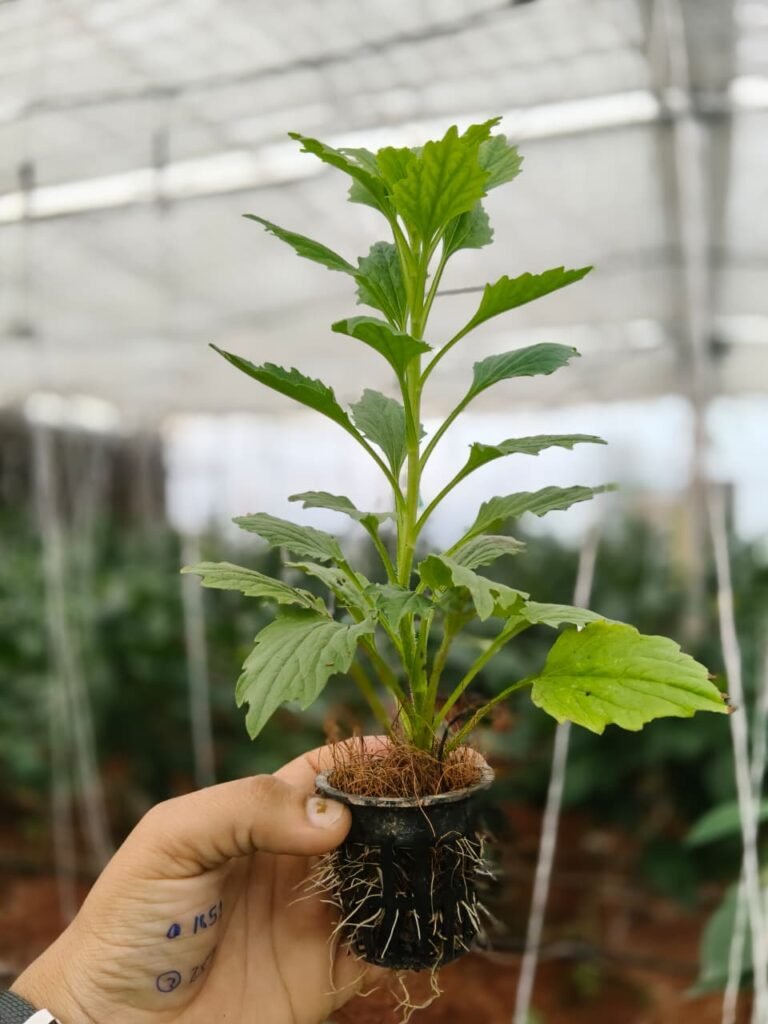
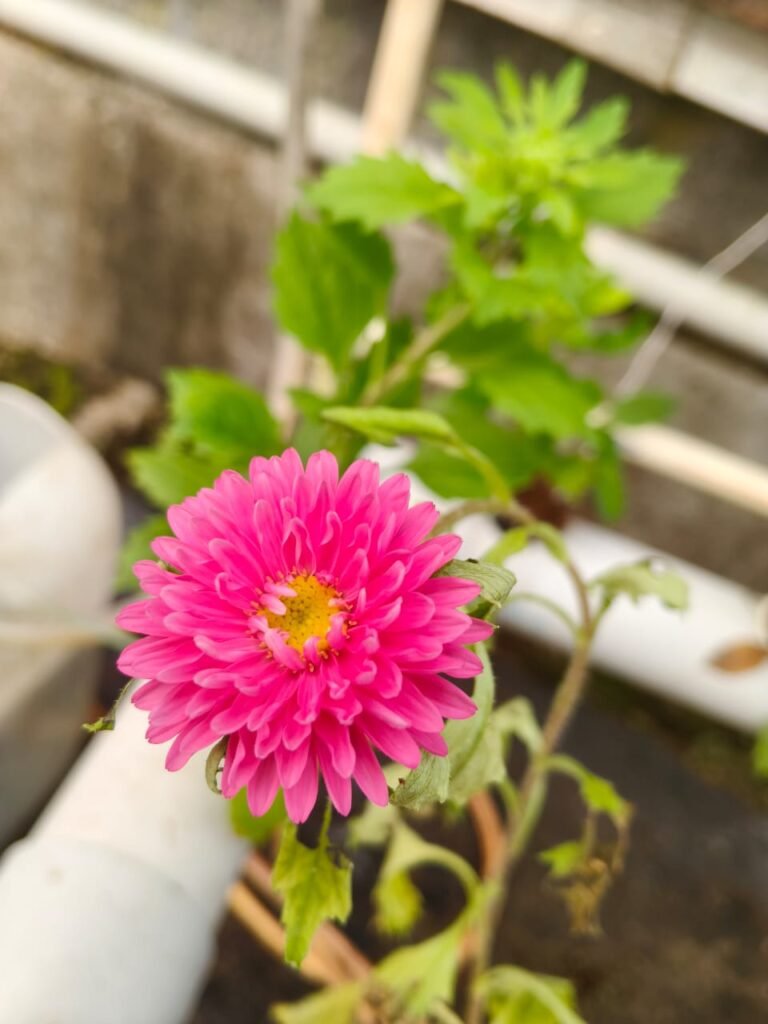
1. EC Range 1.8 m S/cm
Observation:
- Plants show healthy vegetative growth with good leaf color and turgidity.
- Roots are white and fibrous, indicating good oxygen and nutrient balance.
- Flower formation is proper, with bright pink blooms and strong stems.
- No signs of nutrient stress or leaf burn observed.
Conclusion:
This EC range appears optimum for Aster growth in the NFT system — balanced nutrient uptake and healthy flowering.
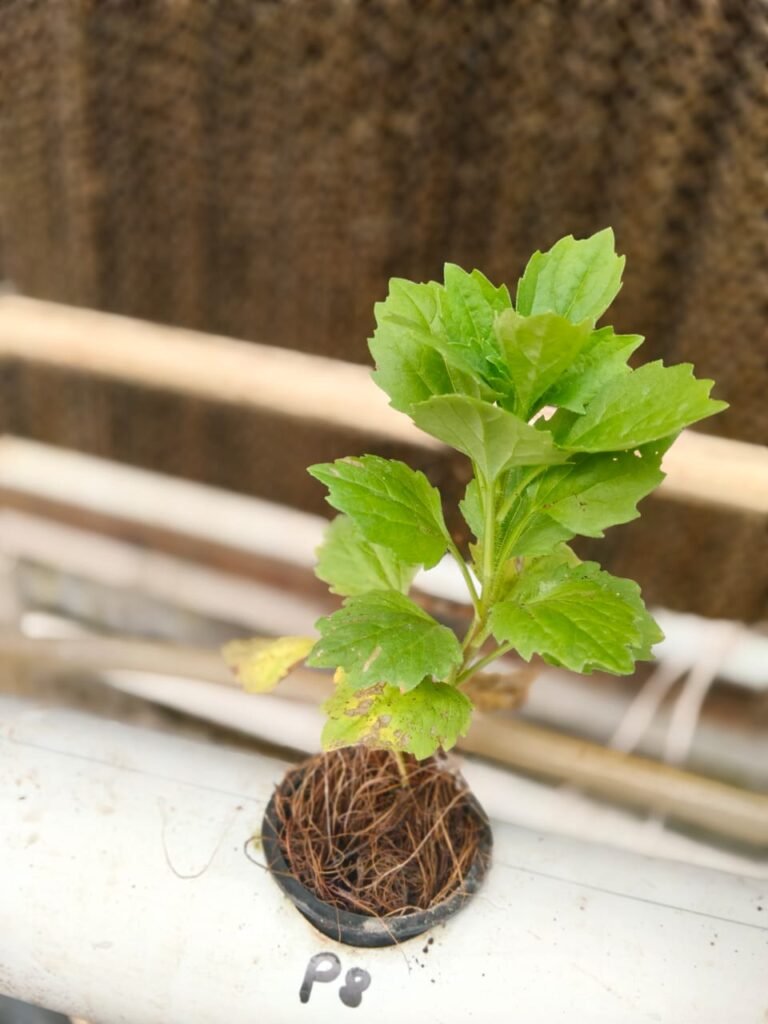
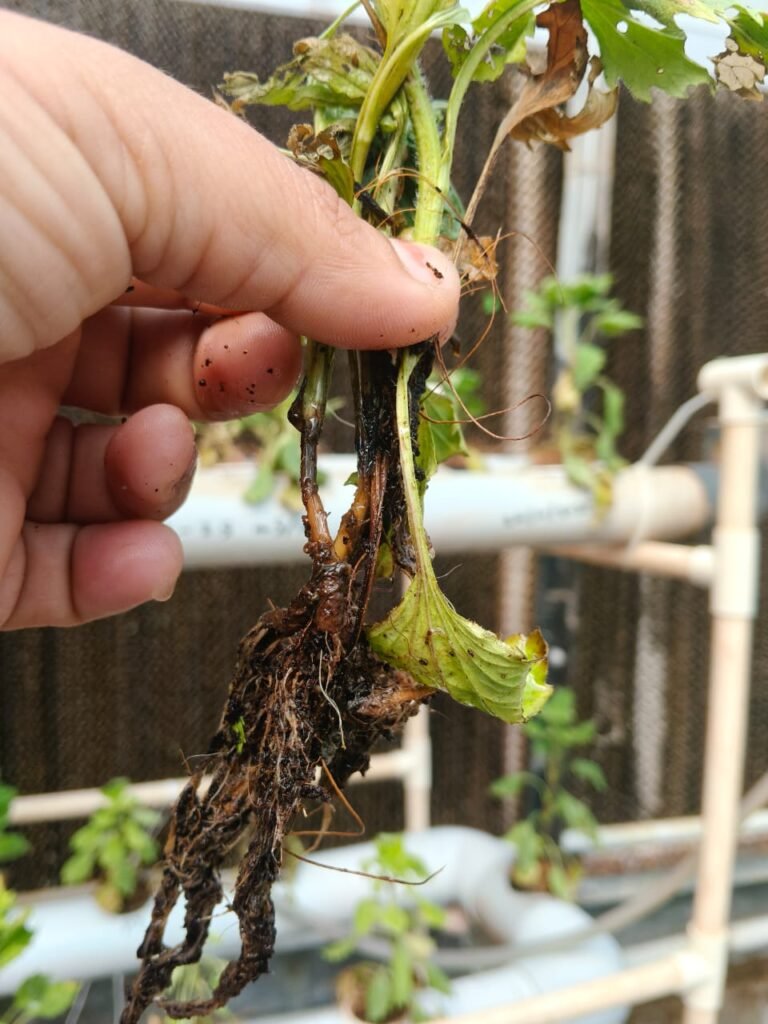
EC Range 2.0–2.2 mS/cm
Observation:
- Plants show moderate growth, but root zone symptoms like slight browning and slimy roots are visible.
- Lower leaves show minor yellowing or tip burn, suggesting early salt stress.
- Flower initiation may still occur, but overall plant vigor is slightly reduced.
Conclusion:
This EC range causes mild stress to the plants. Nutrient concentration may be slightly higher than optimal.
EC Range 2.3–2.5 m S/cm
Observation:
- Plants show visible stress symptoms — reduced leaf size, yellowing, and root rot or blackening as seen in the image.
- Root health is poor, with darkened and decaying roots.
- Growth is stunted and flower development is weak or delayed.
Conclusion:
This EC range is too high for Aster in NFT hydroponics. High salt concentration likely caused root damage and nutrient imbalance. - Detailed Observation – EC 2.3–2.5 m S/cm (High EC Stress)
- Root Condition:
- Roots appear dark brown to black, with slimy or decayed portions, indicating root rot.
- The root tips have stopped elongating, showing restricted growth and oxygen deficiency.
- The high nutrient concentration (EC above 2.3 m S/cm) has likely caused osmotic stress, reducing water uptake.
- Stem Condition:
- The lower stem region is blackened and soft, suggesting onset of fungal infection (possibly Pythium or Fusarium) favored by high salt and moisture stress.
- The stem base appears weak, leading to poor nutrient transport to upper parts of the plant.
19 Nov 2025
To check whether the plants grown under high EC conditions (2.0–2.5 m S/cm) show any improvement, I reduced the EC level to 1.5 m S/cm to observe whether the plants recover and show positive changes in growth and root health .
Expected Effects of Lowering EC to 1.5 m S/cm
- Root Recovery
The root zone stress will reduce because the salt concentration in the nutrient solution will be lower.
Damaged roots may start regenerating fine white roots within 4–7 days if oxygen levels in the NFT system are good.
Root rot progression will slow down, as lower EC improves water uptake and reduces osmotic pressure.



